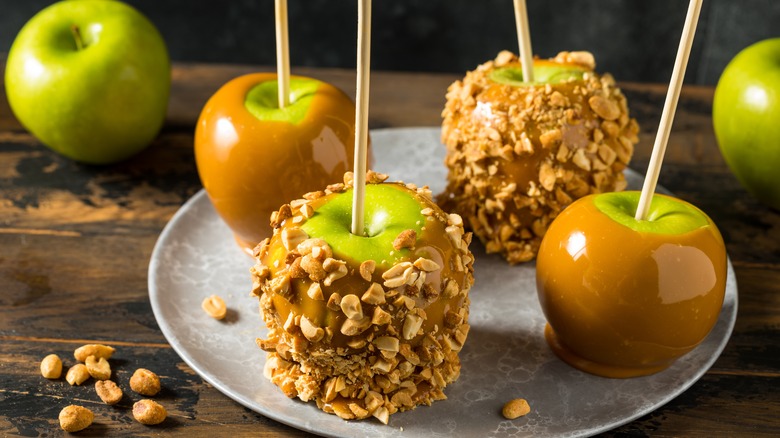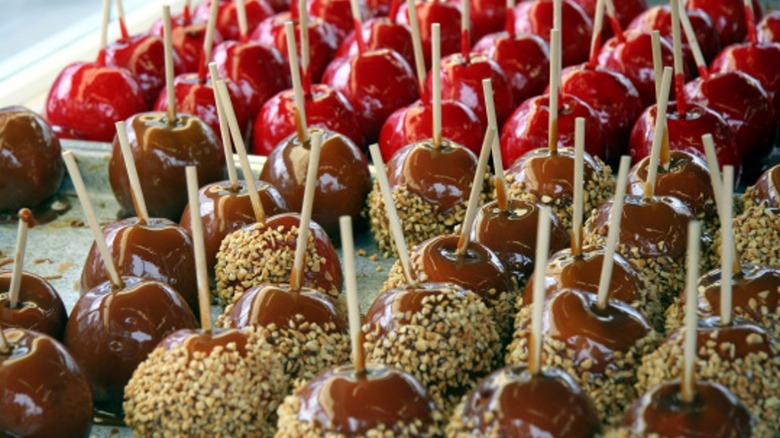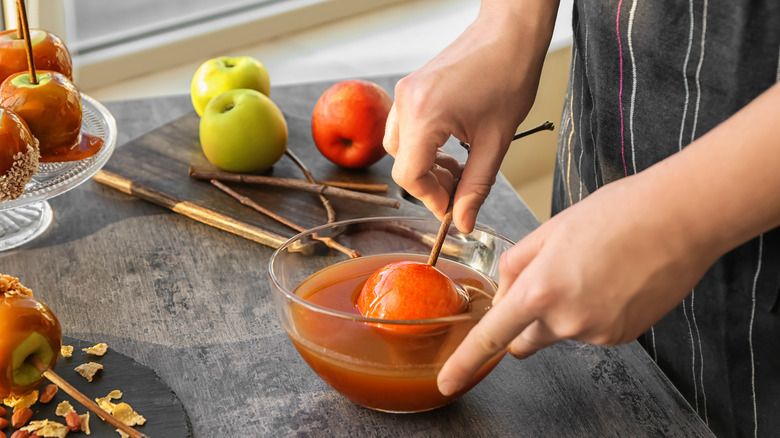How The Iconic Caramel Apple Rose To Fame
Were you ever told as a child that biting down on a caramel apple was a surefire way to get a visit from the tooth fairy? Caramel apples were all the rage as children — we looked forward to that visit to the fair or pumpkin patch so we could gnaw on the sticky, sugary treat on a stick, totally forgetting that it contained an entire piece of fruit inside. As adults, some enjoy the classic treat as a way to indulge in the nostalgia of their childhood, while others reach for it as a way to enjoy dessert without guilt, convinced that an apple covered in caramel is still a slightly healthy dessert option. No matter why you enjoy them, we can all agree that caramel apples are more than just a tasty treat: They are a symbol of autumnal whimsy.
So when exactly did the portable dessert rise to fame? Like many great discoveries, the invention of the caramel apple is said to have happened by accident. Thanks to an excessive amount of caramel candies and some time on his hands, one innovative worker discovered the magical flavor combination of tart apples and sweet, buttery caramel.
Caramel apples are the little sister to candied apples
Until the 1950s, candy apples were the primary apple-on-a-stick desserts. The hard-shelled apple treat was introduced in 1908 and became an instant hit amongst those with a sweet tooth. Nearly fifty years later, legend claims that Kraft Foods employee Dan Walker was the first to replace a hard candied shell with melted caramels. No doubt pulling inspiration from the Halloween fan-favorite, candy apples, the Kraft employee used leftover Halloween caramels to coat an apple on a stick, and the newest dessert was born. Other historians argue that the credit belongs to various candy makers who experimented with ways to sell caramels, but like the origins of many widespread trends, the exact inventor is still unknown.
In 1960, Vito Raimondi invented a caramel apple machine that is still in use today. In a video posted to YouTube, the inventor's granddaughter gave viewers a glimpse at how the machine operates, showcasing caramel apples being dipped, cooled, and packaged at a rapid speed.
Since its inception, the caramel apple has become more elaborate: It is not uncommon to find a caramel apple drizzled in chocolate sauce, covered in nuts and cookie pieces, and even decorated like various characters and fun objects. While some caramel apples are manufactured by machines like Raimondi's, the treat is simple enough that many makers still dip and decorate them by hand.
Caramel apples are easy to DIY
Nowadays, you don't have to wait for the leaves to change to enjoy a caramel apple. Theme parks, fairs, and even some grocery stores have caramel apples on hand ready to be enjoyed at any time of year. You only need a handful of components to recreate this classic childhood treat, all of which can be store-bought and assembled at home. Crisp, green Granny Smith apples are the best to shell in caramel sauce because of their tart flavor profile. A Red Delicious or Fuji apple may be too sweet and soft for optimal caramel apple enjoyment.
As easy as the recipe seems, the process can quickly go awry if you aren't careful. To avoid mistakes while making caramel apples, be sure to double-check that you have all the right ingredients and pay close attention to your cooking temperatures. If you turn the heat up too high or use the incorrect cooking pan, it is far too easy to burn your caramel mixture. If you forget to wipe clean and dry your apples before dipping, you could be left with un-caramelized, waxy apples on sticks. Avoid these mistakes and you'll be once step closer to enjoying the decadent treat that is a caramel apple.


